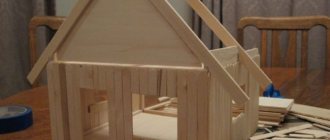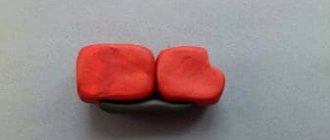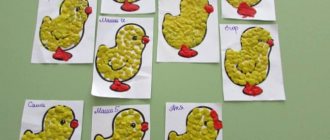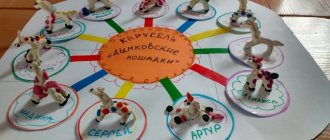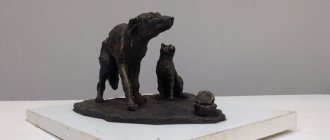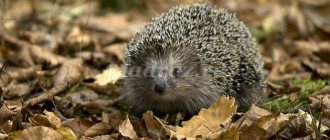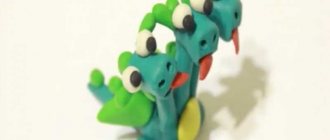GCD modeling in the middle group theme "Fish"
GCD Artistic and aesthetic development. Modeling
Middle group
Theme: Fish
Conducted by a teacher
Sarycheva Lyudmila Viktorovna
Goal: to develop in preschoolers the ability to create the image of a fish using modeling.
Visual tasks: teach children to correctly convey the structure of a fish’s body, proportions of parts, shape, size; develop coordination in the eye-hand system, synchronize the work of both hands.
Technical tasks: learn to divide a block of plasticine into parts; continue to teach children to pinch and pull plasticine away from the main shape (ventral and pectoral fins), to work with stacks (notch, cut plasticine); improve techniques: rolling, unrolling, smoothing.
Educational objectives: to cultivate independence and accuracy in work in preschoolers.
Preliminary work: examination of pictures depicting sea and freshwater fish, game “Loto. Inhabitants of reservoirs”, integration of educational areas: cognitive development, speech development, artistic and aesthetic (drawing), reading the book “To Little Why About the Sea”, riddles, coloring pages “Magic Fishes”, p/i “The Sea Is Worried”, p/i “ Pike and fish”, laying out fish from geometric shapes, “Tangram”, “Fold a square” with the aim of laying out pictures “Underwater World”.
Demonstration material: a large toy fish, a flat fish “Sazan Ivanovich”, on whatman paper there is an image of a lake (“School for young fry”) with algae (desks for fry), technological maps depicting the sequence of actions for creating elements.
1 Organizational part.
Guys, guess the riddle.
Wherever we want, we sail there.
The river is our home, we live in it... (Pisces)
I'll tell you a fabulous story about a fish. In a clear blue lake, next to green algae, lived a good old and wise fish. And the fish's name was Sazan Ivanovich. He had seen a lot in his time, he knew a lot. And Sazan Ivanovich decided to open a school for small fish - fry, in order to teach them wisdom. I wrote an advertisement in the lake newspaper and put up a sign with the inscription “School for Young Fry.” He waited a long time for the young students. He swam to the shore, swam far into the middle, but still didn’t wait. I was upset. Sazan Ivanovich really wanted to tell the kids important and necessary secrets...
Guys, I'm very sorry for the fish teacher. Do you want to help a kind and smart fish? But how can we help Sazan Ivanovich? Right. We will sculpt little fish and students will appear in the “School of Young Fry”.
2. Main part.
Look at the fish toy. Tell me, what parts does the body of a fish consist of?
Sensory examination. The teacher asks leading questions, helping the child to independently identify and compare the main parts and some details.
Finger gymnastics.
| A small fish swims along the river | put your palms together and tilt them to the sides |
| The little fish beats its tail | Stretch your arms forward and alternately wave your hands up and down, imitating waves or a ponytail. |
Teacher: - To start sculpting a fish, you need to divide a block of plasticine into parts. Visually divide it in half and draw a line with a stack. Then we visually divide one half in half again and cut it off - this is the “secret”. We put the “secret” in the upper right corner of the board. From a large piece we will sculpt an ovoid - a body along with a head and tail.
The teacher clarifies how the children will sculpt the ovoid and asks them to accompany the story with hand movements. Then he shows the children how to cut the narrowed part of the ovoid in stacks and move the two resulting halves to the sides - this is the tail.
The teacher calls the child for a demonstration. - Alena, show how you cut the narrowed part of the ovoid and move the cut parts to the sides (show on the finished model).
The teacher reinforces all explanations and demonstrations with mnemonic diagrams.
Teacher: - To make the tail flat and beautiful, we flatten the cut parts and cut them from the inside. Now we make the ventral fins, pinching them on both sides of the body. Nastya, how will you make the dorsal fin (child’s explanation). Do any of you have another option? (child's explanation)
Teacher: - That's right, the dorsal fin can be made by pinching, or it can be done in a constructive way: a small ovoid, flattened and stuck to the top of our fish. To do this, we use the “secret”. We coat the joint and smooth out all the irregularities.
The teacher offers to sculpt small fish. Turns on the music. During modeling, the teacher approaches the children, providing assistance and reminding them of the need to use a wet wipe. Each time he clarifies how the child will do this or that part of the craft. Let's release your fry into the lake. Let's put them at algae desks.
3. Analysis.
The teacher asks the children to tell about the most beautiful fish. He asks why they like her? Notes expressive eyes, a flat beautiful ponytail and a voluminous body, etc. He asks what the names of the fish they sculpted are, and how the dorsal fin was made.
- Guys, hear the bell ringing. A lesson begins at the School of Young Fry. Let's not disturb them.
The P/I “Pike and fry” is being held.
Children tidy up their workspaces, put boards and plasticine back in place, and place napkins to dry.
Plasticine fish for children
This lesson presents an orange fish with yellow fins, it is small and bright, it has bottomless eyes. It’s easy to make such a copy with your own hands, even with children 4-5 years old. Consider in detail the process of creating a craft, you can easily repeat it. Why did we choose fish? This is an unusual option, and also easy to implement.
What you need to create a fish:
- Orange plasticine in two shades for sculpting the body and fins;
- White, blue and black plasticine to create eyes;
- Stack.
How to make a fish for children step by step
During the lesson you can use any color of plasticine. Our fish was made from orange blocks of two different shades. For a toy miniature fish, blue and blue, pink and red, lilac and violet colors are also suitable. Roll a ball from dark orange plasticine. Almost always, modeling lessons begin with rolling out balls.
Use the resulting ball to sculpt the body of the fish. This material will no longer be needed, all fins will be fiery. The shape of the fish's body is unusual, raised at the top. Make a wide triangular piece with a protrusion at the top. Use your fingers to push the top tab back. Make bright orange blanks for the fins and tail. The fish will swim with their help. At least 4 pieces of this color are needed. And if you want, you can also decorate the sides and back with stripes.
Make two flat droplets. Split one of them on one side in the form of an uneven fork and glue it to the back as a tail. Glue the second piece at the top onto the protruding point. Using a stack, apply thin notches to the surface of the fins on both sides. This way, you will get thin membranes that resemble the believable texture of fins.
Make the side fins using the same principle, but they will be smaller and the same in size. Glue huge eyes on both sides of the body. First glue on the white round buttons. Then attach the blue cakes.
Add black dots. Be sure to frame it with flirty eyelashes - our fish should be a beauty. Attach small fins to the sides on both sides symmetrically. Also glue a neat fish mouth in front. Remember that the eyes need to be made on both sides.
The floating beauty is ready. We got not just a sea creature or a bright aquarium fish, but a real collectible toy.
Making crafts with your own hands is always interesting. And now there is no need to go to the store for another expensive new thing - everyone can feel like a manufacturer of unique children's goods if there is plasticine in the house.
How to sculpt fish from plasticine
You can make many different crafts with plasticine fish. And with fish made from salt dough or polymer clay, the modeling technique of which is no different from modeling from plasticine, you can make even more crafts and souvenirs due to the fact that it is more convenient to store products made from them.
True, fish made from salt dough and even my favorite light polymer modeling mass are not suitable for placing them in a jar of water; for this, the fish must be made from ordinary plasticine. But with such fish you can make other crafts: applications on cardboard, aquariums on lids and other waste material.
The fish themselves can also be made in different ways, depending on the age and skills of the child.
Method 1. How to make a fish with kids using a mold
The easiest way to make a fish from plasticine.
- Roll out a piece of plasticine into a layer (cake) with a special small rolling pin or an even thick felt-tip pen.
- Cut out the fish with a mold. Cookie cutters, play dough kits, or pastry chef kits are suitable for this purpose.
- After this, you can leave the fish in this form or, using sculpting tools, draw eyes, a mouth, stripes on the tail and fins, and make the scales into a drinking straw or, if the size of the fish allows, from sequins.
Method 2. How to make the simplest fish with babies
- Roll the plasticine with a roller (sausage).
- Bend it with a loop and cross the ends.
- If desired, glue an eye from a flattened small plasticine ball or a ready-made plastic eye for crafts. You can also add small pieces of plasticine - fins.
Method 3. How to sculpt a fish (sculpture)
- Roll out a short thick roll (sausage) from plasticine.
- Flatten it with your fingers so that you get a fish’s head on one side and a tail on the other. To make the thin part in front of the tail, you need to stretch and squeeze the plasticine with the fingers of one hand, and flatten it with the fingers of the other hand. Make an indentation in the tail with your finger too.
- Make eyes into sharp parts of the stack or press beads into plasticine.
To make the fish striped, you need to twist plasticine rollers of two colors together and make a fish from the resulting roller.
Method 4. How to make a fish based on a circle or oval
- Roll into a ball and give it the shape of an egg.
- Flatten, trying to make one edge more elongated and the other rounded.
- Using a stack, cut two triangular holes as in the photo.
- Make a mouth, stripes on the tail and fins. Use a drinking straw to make scales, placing the straw at an angle and pressing on it so that not a circle, but an arc is imprinted on the plasticine.
- Roll a very small white ball and a very small black one. Flatten the balls, glue black on white - you get an eye.
- Glue it to the fish.
Method 5. How to make a fish with a round or oval body
To work, you will need plasticine of two colors: one color for the body, the other for the fins and tail.
- Getting started - roll balls for future necessary parts.
- Flatten the largest ball (for the body of the fish) into a circle or oval.
- Make a short roll from the middle ball, bend it into a checkmark shape - this is the tail.
- Use your fingers to shape the small balls into droplets and flatten them.
- Attach the tail and fins to the body.
- Make eyes.
Method 6. How to make a fish from triangles
- Make two squares of different sizes from plasticine.
- Cut each in half diagonally.
- Make a depression in the small triangle, extend the corners of the large triangle a little, give them the shape of fins.
- Attach the small triangle (tail) to the large one.
- Make an eye, strips of thin plasticine flagella.
Various options for crafts with comments and descriptions of execution methods
Most of the fish (photos 1–6) are made using a combined method: the head and body are sculpted from one large piece of plasticine, while the remaining elements (tail, fins, eyes) are attached separately.
are made using a combined method: the head and body are sculpted from one large piece of plasticine, while the remaining elements (tail, fins, eyes) are attached separately.
The fish in photo 4 “Goldfish” looks very impressive - a beautiful long red tail, detailed scales and bulging beady eyes.
Photo 5 “Aquarium with fish” shows modeling using the bas-relief method - the fish are attached to the surface, protruding approximately halfway. The original composition is complemented by pebbles, shells and algae.
The “Magic Fish” craft is of interest (photo 7): the body is made of a twisted flagellum. The gradient color (transition from pink to lilac) will look interesting.
Photos 9 and 10 show volumetric aquariums. Sea creatures are attached to the walls of the cans or fixed in the center on special fasteners.
Video: cartoon “Wow, the talking fish” (1983)
https://youtube.com/watch?v=LUYHnRAinJEVideo can't be loaded because JavaScript is disabled: Cartoon “Wow, a talking fish!” (https://youtube.com/watch?v=LUYHnRAinJE)
Video: cartoon “In the blue sea, in white foam” (1984)
https://youtube.com/watch?v=wCpIuwelvwkVideo can't be loaded because JavaScript is disabled: In the blue sea, in the white foam cartoon, 1984 (stay with us boy) (https://youtube.com/watch? v=wCpIuwelvwk)
Video: “The Tale of the Fisherman and the Fish” by A. S. Pushkin
https://youtube.com/watch?v=D07xru9L7JkVideo can't be loaded because JavaScript is disabled: Pushkin's Tales - The Tale of the Fisherman and the Fish (https://youtube.com/watch?v=D07xru9L7Jk)
Most preschoolers love to sculpt, because this is an opportunity to create a new toy for themselves. Object modeling, which includes creating a fish, will certainly captivate children in the middle group, especially if the teacher introduces them to various options for creating the image of sea creatures. And the use of additional materials will make the lesson bright and memorable.
How to make a fish from plasticine.
The next lesson on making crafts from plasticine will interest children of all ages. This time it will not be just a craft, but a whole picture in which there are no limits to your imagination! Performing such a composition is a great way for parents to have fun with their child. Mom can sculpt one part, and the baby another, and in the end combine everything into one craft. With your help, your child will be able to do more and more difficult work each time, and you will become his main teacher. Don’t be upset if your child is not interested in such an activity, put it off for a while and next time offer to make, for example, a character from his favorite cartoon. This idea will definitely help you teach your child how to make any crafts from plasticine. Now let's go back to our picture. We invite you to sculpt the main underwater inhabitant - a fish. For this we need:
- soft plasticine of all colors of the rainbow and more. The more there are, the brighter and more fun our fish will turn out;
- base for the picture: a board or thick cardboard.
This is the kind of fish you and I will get.
First we need to draw the fish itself. Take plasticine of any color, in our lesson we’ll take blue. Roll into a thin sausage.
Lay it out so that it looks like a fish.
Take pink plasticine and paint over the lips of our fish.
Use a thin blue sausage to separate the area where we will further attach the scales.
To decorate the body of the fish, roll a lot of multi-colored balls of any color and size.
From the base of the tail, start laying out small balls, pressing them down so that they turn out flat.
Lay out the whole body of the fish like this. The order of colors depends only on your imagination and imagination. Now we need to make an eye using white and black plasticine.
Now it’s time to decorate the tail of our funny fish. Make several thin sausages from plasticine of different colors.
Lay them out as shown in the picture.
From the remaining thin parts, make fins on top and bottom of our fish.
Our miracle fish is ready to go swimming! Thank you for your attention, we hope you enjoyed our master class!
If you find an error, please select a piece of text and press Ctrl+Enter.
Olesya Selikhova
About the author: Psychologist, specialist in the field of family relationships and raising children. I love drawing, modeling, needlework and any interesting creativity. Mom raising two children and a wonderful wife!
How to make a fish from plasticine
From all of the listed types of plasticine you can make original things and animals. Let's look at an example of how to make a molded fish from plasticine.
Depending on the further function of the future fish, suitable plasticine is selected. Choosing a color is not a very important procedure, since the fish can be anything. It is advisable to wear an apron to avoid getting dirty. You should definitely check that you have the necessary tools: lids of different sizes, a steak for cutting plasticine, a special knife. You can use a comb to make the fins and tail of the fish.
Take plasticine. A circle is rolled out of it, approximately the size of a fish's head. The resulting ball is slightly flattened. Next, another plasticine is taken, rolled out, flattened and cut into three parts with a knife, from which fins and a tail are made. Using a comb, they are decorated with tooth marks. Next, the resulting parts are attached to the head of the fish. Small balls are then rolled out and attached like lips. The lids make small imprints of the gills. The final touch is to draw scales on the body of the resulting product using the body of the pen. Beads are attached instead of eyes. The plasticine fish is ready.
Then it can be glued to the frame and decorated with various seaweeds also made from plasticine. The resulting picture can be hung on the wall or given to friends. In any case, it will give an unusual look to the room.
